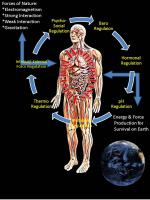|
This section contains 965 words (approx. 4 pages at 300 words per page) |

|
In 1865 French physiologist Claude Bernard pointed out that in order for an organism to survive, a constant, or stable, internal environment was required. Based on this insight, and more than half a century later, in 1929, a physiologist from Harvard University, Walter B. Cannon, coined the term "homeostasis." Homeostasis means a stable state of the internal environment that is maintained by regulatory processes despite changes that may occur in the external environment.
Like the first animals to evolve, simple animals such as sponges and jellyfish have a body wall that is only a few cell layers thick, and each cell has direct access to the external environment. As a result, cells can take up nutrients and dispose of wastes by direct exchange with the external environment, but they are also directly exposed to fluctuations in that external environment. Such fluctuations (e.g., in ion concentrations or temperature), will affect...
|
This section contains 965 words (approx. 4 pages at 300 words per page) |

|


